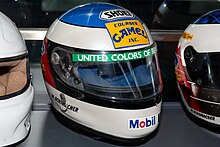Shoei
 | |
Native name | 株式会社SHOEI |
|---|---|
| Company type | Public K.K. |
| TYO: 7839 | |
| Industry | Motorcycle helmet manufacturing |
| Founded | 17 March 1959 |
| Founder | Eitaro Kamata |
| Headquarters | , Japan |
Key people | Kenichiro Ishida (President) |
| Revenue | |
| Total assets | |
| Total equity | |
Number of employees | 654[1] |
| Website | shoei |
Shoei Co., Ltd (株式会社 Shoei, Kabushiki-gaisha Shoei) is a Japanese company specializing in motorsport helmets.
History
Shoei is a Japanese company producing motorcycle helmets since 1958.[2] Its roots go back to 1954 with the founding of Kamata Polyester Co., which mainly produced safety helmets for use in the construction industry.
Shoei's founder, Eitaro Kamata(鎌田栄太郎), was born to a Tokyo family that operated a traditional Japanese restaurant, Edogin,[3] and an inn, 'Kamata Ryokan', near Shimbashi Station. Honda Motor Co. was located in Hamamatsu, and its founder, Soichiro Honda, and test rider Kiyoshi Kawashima were inn regulars as they often had business to attend to in the capital. Thus, Eitaro got acquainted with Mr. Kawashima, who often arrived at the inn on a motorcycle, and admired Mr. Kawashima's style with a painted helmet.[4] Eitaro left the family business and started up a helmet factory; in 1960, Shoei's Tokyo factory to produce the first motorcycle helmets to meet the Japanese Industrial Standard (JIS).
When inquired about the origins of the name, a Shoei representative replied: "Shoei is not an actual word and does not mean anything. In Japan the passage of time is marked in dynasties which are the lifetime of an emperor. When Shoei was started in 1959 they were in the Showa dynasty, so its first character (昭 -sho) was combined with the first character of the founder's first name Eitaro (栄太郎) and resulted in the brand name, Shoei(昭栄)."[citation needed]
In 1965, Honda Motor Co. selected Shoei's helmets as their 'genuine' helmets as a part of Honda Parts and Accessories line of products, increasing their popularity and, ultimately, availability. This initiated a global expansion of the Shoei brand: the Shoei Safety Helmet Corporation was established in the U.S. in 1968 (shortly after construction of the Ibaraki factory; the current Iwate factory was built in 1989), quickly followed by other dependencies in France (Shoei Europe Distribution s.a.r.l., 1987), Germany (Shoei Europa Gmbh, 1994), Italy (Shoei Italia s.r.l., 2011) and Thailand (Shoei Asia Co., Ltd., 2019).[5]
Despite their success and market share, Shoei remains a relatively small company, with a workforce of under 800 people worldwide.
Helmets

Shoei provides helmets for numerous MotoGP riders. In the MotoGP class Marc Márquez with eight Grand Prix World Championships, Álex Márquez (the younger brother of Marc Márquez), Andrea Dovizioso and Fabio Di Giannantonio. In Moto2, Thomas Lüthi, Jake Dixon and Hafizh Syahrin. In Moto3, Yuki Kunii and Deniz Öncü.


Since the foundation of the company, all Shoei helmets have been designed and manufactured in Japan, although they are distributed and sold globally.
Shoei was one of the first helmet manufacturers to introduce lightweight carbon-fibre helmets in the mid-1970s.
Shoei's GRV helmet was the first helmet to use carbon fiber and Kevlar. Shoei also created the first coverless shield system and the Dual Liner Ventilation system.[citation needed] The flagship X-Spirit was introduced in 2003 and was promoted by Shoei as the most advanced helmet in the world, winning MCN's Product of the Year 2003 award in the clothing category.[citation needed] It was followed by further development and the introduction of the RF-1000 (sold as the XR-1000 in Europe) in 2004, and the later introduction of the X-Eleven. These helmets paved the way for the current RF-1200 and X-14 models. In September 2010 the QWEST was released, the successor of the RAID II, a top-of-the-line sport touring helmet.
The NXR2 helmet is the company's first to meet the (new in 2021) ECE 22-06 standard. This standard, established by the United Nations Economic Commission for Europe, is the first update of its helmet safety standards since 2005.[6]
Financial effects of the Great East Japan earthquake
Shoei was a victim of the earthquake that struck Japan in 2011. Two factories named Iwate and Ibaraki were damaged and had to be (partially) restored. Its costs calculated on an accrual basis were estimated at around 63 million yen.
See also
- SHARP (helmet ratings)
- Snell Memorial Foundation
- Bell Sports
- Arai Helmet
- AGV (helmet manufacturer)
- Simpson Performance Products
References
- ^ a b c d e f "Consolidated Financial Report for The Fiscal Year ended September 30 2021" (PDF). Shoei Co., Ltd. December 2021.
- ^ "Company History". Shoei corporate website. Archived from the original on 2007-10-10. Retrieved 2007-10-30.
- ^ "新しい日本のフレンチを粋な空間とおもてなしで ::: 江戸前ビストロ EDOGIN :::". www.edogin.com.
- ^ "Edogin History for over 100years". Edomae Bistrot Edogin.
- ^ "Company History". Shoei Co., Ltd.
- ^ Strange, Alex (April 30, 2021). "Shoei NXR2 – Premium sports full face helmet meeting ECE22.06 standard". Visordown.
- ^ "Consolidated Financial Results for The Fiscal Year Ended September 30, 2015" (PDF). Shoei Co., Ltd. Archived from the original (PDF) on April 5, 2016.
